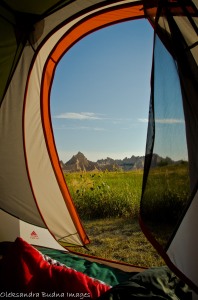After a long drive from Tampa and a stop for groceries, we finally crossed the bridge to the Keys just as the sun was about to set down. We stopped for dinner at the aptly named Sundowners restaurant in Key Largo. More yummy seafood plus beautiful views.

Camping at Sugarloaf Key
Our destination was a KOA campground down at the Sugarloaf Key. My original plan was to book a site at Bahia Honda or any other state park in Florida Keys. Unfortunately, since campsite reservations for Florida parks open eleven months in advance, there were no campsites left by the time we started planning our trip. After some research, I found a KOA campground not far from Key West. During our road trips, we often book cabins at various KOAs for one- or two-night stops. It is less expensive than a hotel room and doesn’t interfere with the whole camping vibe of the trips. We weren’t sure about tenting, though, since the tent sites we’d seen at different KOAs varied significantly – from decent-size wooded lots to small pebble-covered patches tucked in between RVs. The site we got at this KOA exceeded our expectations by a lot: it was further away from the RVs, and had lots of shade and space (enough space to even play soccer). We then discovered that there were other tent areas, with the green one (where we stayed) and the yellow one being the best. All the others were across from the RV area, which looked more like a parking lot than a campground and made me claustrophobic every time I had to walk through it.



The campground as a whole was far from the wilderness camping experience we are used to and reminded more of a resort with its own bar, café, tiki huts and inflated bouncing and climbing structures in the beach area. It had some nice features, though, like kayak, canoe and boat rentals, and was a good base for exploring the Keys and visiting Key West (plus we had lots of wilderness waiting for us over at Everglades). We stayed there for three days going on bike rides, kayaking, soaking up the sun and watching pelicans and iguanas. Pelicans were abundant, especially around the fish cleaning station waiting for occasional fish remains or lining up on the fishing bridge seemingly oblivious of the people right next to them. Dozens of iguanas were sunning in the mangroves, their striped tails hanging among the branches. It was a fun game to see who could find the most of those masters of disguise. Sometimes, they would scatter around the campsite or play hide-and-seek around the car. (For more pictures of pelicans and iguanas, go to my Random|Pix blog.)








The best part of the trip, of course, was getting to spend time with my family, my brother and his wife. In the evening, we would have long conversations around the fire or listen to our friendly neighbour Roger play his guitar.

Key West
We dedicated one day to exploring Key West since it was only 20 miles away from the campground. Instead of driving there, we decided to take public transit. There is a bus running all the way through the Lower Keys and it only costs $4 for adults and $2 for kids. Biking would be another green transportation option since there is a bike lane along most of Highway 1 that runs from Key Largo to Key West. The bus does take some time, though, since it makes frequent stops and circles a bit around Stock island and Key West but then you don’t have to worry about finding parking, not an easy task in a town as busy as Key West.

Key West is a pretty, lively town at the very south of Florida Keys so almost everything has ‘Sounthernmost’ in its name, like “Southermost Hotel’ or ‘Southernmost Beach.’ The southernmost point in continental USA actually features a huge buoy with the ’90 miles to Cuba’ marker, a very popular destination with a huge lineup of people wishing to take a picture in front of it. I guess this fascination can be explained by the fact that for now Americans can’t get any closer to Cuba. ’90 miles to Cuba’ is another popular sign you’ll see around the city.




Key West, just like the rest of the Keys, has a bit of a Caribbean vibe. Beautiful houses, tropical plants, roosters wandering in the streets, lots of restaurants and cafes, delicious seafood (again), yummy ice-cream and famous Key Lime pie, music and dancing everywhere. And, of course, the sunset celebration at Mallory Square with flaming skies and street performers.








We had great time exploring the city and taking silly pictures, like looking over the fence of Hemingway’s House or pretending to be taking a selfie with a statue at the Museum of Art and History.




For more pictures of Key West, check out my Random|Pix blog.
Before long, it was time to leave Florida Keys. As always, it felt that there was so much we hadn’t done. We had plans to stop at Bahia Honda Park on the way back since it has the best beach in all of the Keys. Unfortunately, the day use area was packed so we had to readjust our plans. We ended up at Sombrero Beach, a lovely public park in Marathon. It felt surreal to be swimming in the ocean at the end of December and the water was the warmest we’d experienced in 2014 (yes, much warmer than the lakes in Canada were this past summer). After a few hours on the beach and a grocery shopping trip, we headed for Everglades, with a beautiful Florida sunset in our rear-view mirror.






Off to Everglades…













































